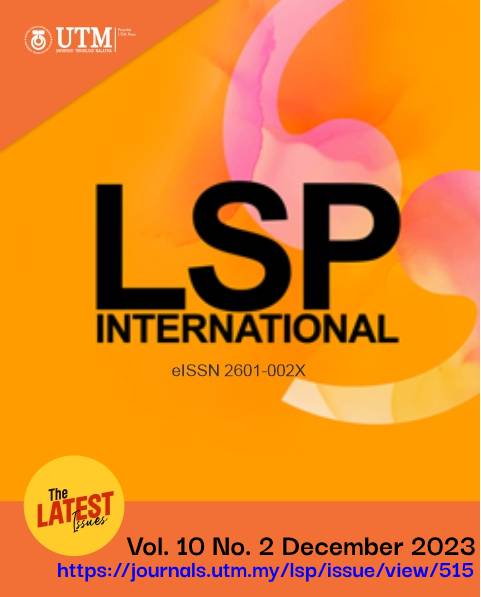A Comparative Investigation on the Metaphors in Chinese and American Mainstream Media
DOI:
https://doi.org/10.11113/lspi.v10.20228Keywords:
Covid-19, Editorial, Crisis, MetaphorAbstract
Since COVID-19 outbreak in December 2019, there is a “narrative battle” between China and the US. Through rhetorical devices, such as metaphors, mainstream media plays a significant role in society in shaping public opinions. Although scholars have started to explore the metaphors employed between Chinese and American media during the pandemic, there is less information about a systematic comparative study on the COVID-19 related metaphors in Chinese and American media. This study provides a comparison of the metaphors in the COVID-19 editorials in the China Daily (CD) and the New York Times (NYT) through grounded theory. In general, it determines CD employs more metaphors than that in the NYT. In addition, the employment of war metaphor in NYT to describe the coronavirus is way more less than that in CD. Also, both CD and NYT tries to envoke the public through the employment of impressive historical issues.
References
Ahmad, N. (2022). Dear Free Malaysia Today — Your words matter: COVID-19 and its subtle rhetoric. SEARCH Journal of Media and Communication Research, 14(1), 19-32.
Goffman, E. (1974). Frame analysis: An essay on the organization of experience. Harvard University Press.
Wen, J. et al. (2020). Effects of misleading media coverage on public health crisis: A case of the 2019 novel coronavirus outbreak in China. Anatolia, 31.
Denham, B. E. (2014). Intermedia attribute agenda setting in the New York Times: The case of animal abuse in US horse racing. Journalism & Mass Communication Quarterly, 91(1), 17-37. https://doi.org/10.1177/1077699013514415.
Connor, U. (1996). Contrastive rhetoric: Cross-cultural aspects of second-language writing. Cambridge: Cambridge University Press.
Chun Tie, Y., Birks, M. (2019). Francis K. Grounded theory research: A design framework for novice researchers. SAGE Open Medicine. 7. Doi:10.1177/2050312118822927.
Chiang, W.-Y., & Duann, R.-F. (2007). Conceptual metaphors for SARS: War between whom? Disc. Soc. 18, 579-602. Doi: 10.1177/0957926507079631.
de la Rosa, M. V. M. (2007). A global war against avian influenza. RAEL, 6, 16-30.
de la Rosa, M. V. M. (2008). The persuasive use of rhetorical devices in the reporting of ‘Avian Flu. Vigo Int. J. Appl. Linguist, 5, 87-106.
Eunice Castro Seixas. (2021). War metaphors in political communication on Covid-19. Sec. Media Governance and the Public Sphere. https://doi.org/10.3389/fsoc.2020.583680.
Xiao, Y. M. (2021). A comparative analysis of war metaphors in COVID-19 reports in New York Times and China Daily. Journal of Contemporary Educational Research, 5(5). 10.26689/jcer.v5i5.2155.
Denissen, Jaap & Butalid, Ligaya & Penke, Lars & Aken, Marcel. (2008). The effects of weather on daily mood: A multilevel approach. Emotion (Washington, D.C.), 8, 662-7. 10.1037/a0013497.
Semino, E. (2020). Not soldiers but fire-fighters – metaphors and Covid-19. Health Communication, 36(1). https://doi.org/10.1080/10410236.2020.1844989.
Charteris-Black, J. (2017). Fire metaphors: Discourses of awe and authority. Bloomsbury.
Hart, C. (2017). Riots engulfed the city: An experimental study investigating the legitimatin effects of fire metaphors in discourses of disorder. Discourse & Society, 29(3), 279-298. https://doi.org/10.1177/0957926517734663.
Yu, Y. T. (2022). Legitimizing a global fight for a shared future: A critical metaphor analysis of the reportage of Covid-19 in China Daily. Pandemic and Crisis Discourse: Communicating Covid-19 and Public Health Strategy. P242;
Lakoff, G. (1993). The contemporary theory of metaphor. In A. Ortony (Ed.). Metaphor and thought (pp. 202–251). Cambridge University Press. https://doi.org/10.1017/CBO9781139173865.013.
Liu, X. (2006). Analysis of the development of China’s English newspaper. Press Circles, 5, 74-75.
Liu, Y.Q. et al. (2018). Research on International Communication Strategy of China Daily Editorial. International Communication.
Das, A. (2009, May). Political Crisis and Medias Role towards Conflict Resolution: A Study in Indian Contex. Proceedings and E-Journal of the 7th AMSAR Conference on Roles of Media during Political Crisis (Vol. 20, pp. 1-17). https://doi.org/10.1.1.542.3015&rep=rep1&type=pdf.
China Daily. (2020, Feb. 09), “Belittling of China's struggles in fight against the virus betrayal of humanity. https://www.chinadaily.com.cn/a/202002/09/WS5e3ff669a310128217276140.html.
Arumugam, T. (2020, February 18). Covid-19 outbreak causing people to spread fake news, stirring up xenophobia. The Straits Times. https://www.nst.com.my/news/nation/2020/02/566613/covid19-outbreak-causing-people-spread-fake-news-stirring-xenophobia.
China Daily. (2020, Feb. 18). Economic immunity boosters will ensure epidemic not chronic ill. https://global.chinadaily.com.cn/a/202002/18/WS5e4bca4da3101282172787ad.html.
Haynes, S. (2020, March 6). As coronavirus spreads, so does xenophobia and anti-Asian racism. Time. https://time.com/5797836/coronavirus-racism-stereotypes-attacks/.
The New York Times. (2020, Mar. 17). Stop saying that everything is under control. It isn’t. https://www.nytimes.com/2020/03/17/opinion/war-crononavirus-trump-production.html.
The New York Times. (2020, Mar. 17). China’s Ill-Timed Attack on the Free Press. https://www.nytimes.com/2020/03/17/opinion/china-journalists-coronavirus.html.
The New York Times. (2020, Apr. 22). Covid-19 Threatens Global Safety Net. https://www.nytimes.com/2020/04/22/opinion/covid-who-imf.html.
China Daily. (2020, Mar. 18). Futile attempt to deflect domestic pressure: China Daily editorial.https://www.chinadaily.com.cn/a/202003/18/WS5e711a94a31012821727fdd0.html.
The New York Times. (2020, May. 04). Mr. Trump’s war on accountability. https://www.nytimes.com/2020/05/04/opinion/inspector-general-trump-coronavirus.html.
















